10 steps to jump-start your intranet
What does it take to get an intranet project from concept through to reality? What are the vital steps involved in delivering a successful project?
A successful intranet has the capacity to transform how you communicate, collaborate, and work as an organization. However, when you’re just starting out at the beginning of a project, it can feel overwhelming.
Download the essential intranet guide today
How do you manage all the different requirements and expectations? What should it look like, how will it be structured? Do you have enough resource available to get it off the ground? How long will your timeline be and do you require a software proof of concept before implementation?
Effective planning and a methodical approach are essential. Here’s our 10-step process to getting your intranet off the ground, and into your organization.
1. Define purpose/vision
Without direction, your intranet project will fail. Start by creating a vision for your intranet. Ask yourself and your stakeholders:
- What will be the overarching purpose of our intranet?
- What is it for?
- Does this vision align with and support our company’s overall vision and objectives?
If you created a business case or a request for proposal for your intranet project, you may find some of the opportunities identified at this stage will support you in defining the overall purpose for your new intranet.
As an example, UK children’s charity NSPCC defined their intranet purpose and vision with an opportunity statement:
The key objectives of the project are to replace the existing intranet with a new one with:
- Promotes organizational culture and reflects ‘one’ NSPCC
- Enables staff to share stories, inspires and engages staff, celebrates success, and demonstrates impact
- Encourages & facilities learning, communication & collaboration
- Builds organizational knowledge
- Helps staff to do their jobs
- Improves business efficiency.
2. Define objectives
Thinking about your intranet vision, what are the specific objectives that it should meet in order to achieve its overall purpose? How can they be measured? How will you know if your intranet is a success?
Most intranet projects have a couple of main objectives and a number of secondary objectives. These will help to focus and guide your project, not only during the build and launch phase, but for the lifetime of your intranet. Although many measures of success for an intranet are traditionally generic or ‘soft measures’, such as ‘improved employee engagement’, ideally you should look to include some ‘hard’, or specific and measurable objectives that are SMART (Specific, Measurable, Achievable, Relevant, and Time-bound.)
| Generic objectives – high level, may be difficult to quantify | Specific objectives – more precise, often quantifiable in terms of a numerical value or timeframe | ||
|---|---|---|---|
| 1 | Improve internal communication | Increase revenue by $x | |
| 2 | Increase cross-departmental collaboration | Reduce costs and overheads by x% | |
| 3 | Enhance knowledge sharing | Decrease average customer call handling time by x mins |
Example of generic vs. specific objectives
These will not only help to steer continued improvements and provide focus for your intranet, but will also help you define and demonstrate the ROI of your intranet.
Example objectives:
#1: Increase Adoption
You can measure adoption rates using the number of active users, usually found in the analytics of your intranet.
Make it SMART: Reach 80% of users active on the intranet every month within 3 months after launch.
#2: Reduce email traffic
You may require IT departmental support to help define and then measure this objective. Request a ‘benchmark’ figure of the average volume of internal email traffic for your organization prior to the launch of your intranet. What tasks or information are you centralizing to your intranet that employees may have historically sent an email for?
For example, if you are placing workflows such as booking a leave of absence on your intranet, or hosting business-critical information such as your 401K / pension policy on your intranet, all of these will help reduce the number of emails sent within your business.
In addition, if you are moving other communication methods to your intranet – such as distribution of company-wide news, or your staff ideas forum – these can also help reduce email volumes.
Make it SMART: Reduce internal email traffic by 10% 3 months after launch, compared to prelaunch levels.
#3: Make users easily findable with a centralized employee directory
This can be measured using the Profile Completeness score, visible on the individual profile of each user and measured in the Analytics section of your intranet.
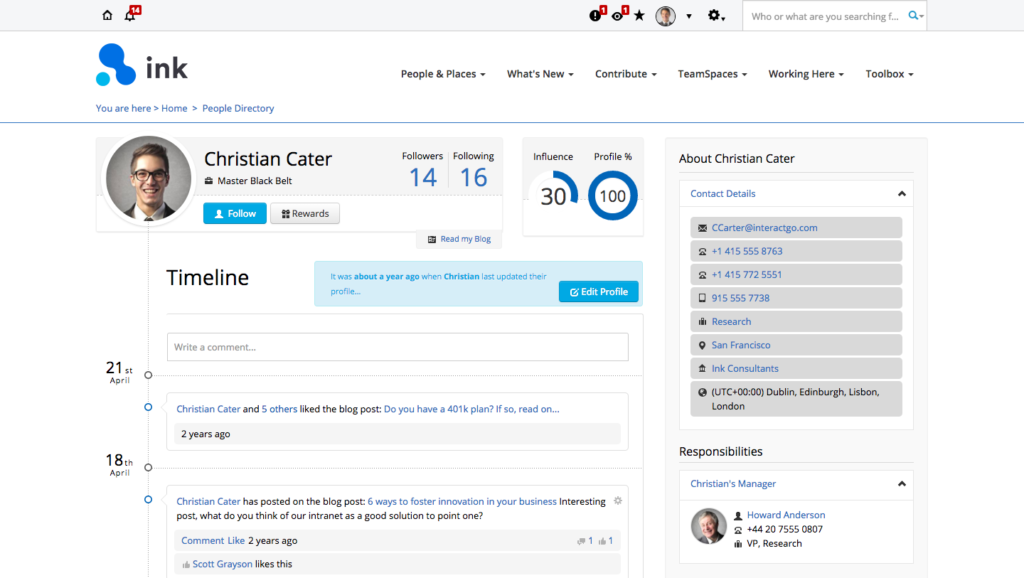
Make it SMART: Every user to have a 100% profile completion score in the intranet People Directory 1 month after launch.
#4: Create a centralized repository for all vital company policies and documentation which is easily searchable
This objective can be measured both in terms of the volume of information stored in internal drives, and the number of queries directed to the areas of your business that own those documents or information.
Make it SMART: a 20% reduction in the volume of information stored on internal shared drives within 3 months of launch / 80% of all policy queries conducted using intranet search by month three after launch.
#5: Provide a single point of access to business systems, apps, and tools
If you choose to integrate with essential business systems or provide quick access from your intranet utilizing Single Sign-On (SSO) functionality, this can save valuable employee time, reduce the threat and risk of weak or forgotten passwords, and improve the overall employee experience of your digital workplace. Measure by surveying users or, if available, utilizing the analytics of your existing systems about how those users access them.
Make it SMART: 80% of users access their daily tools via the intranet by month three after launch.
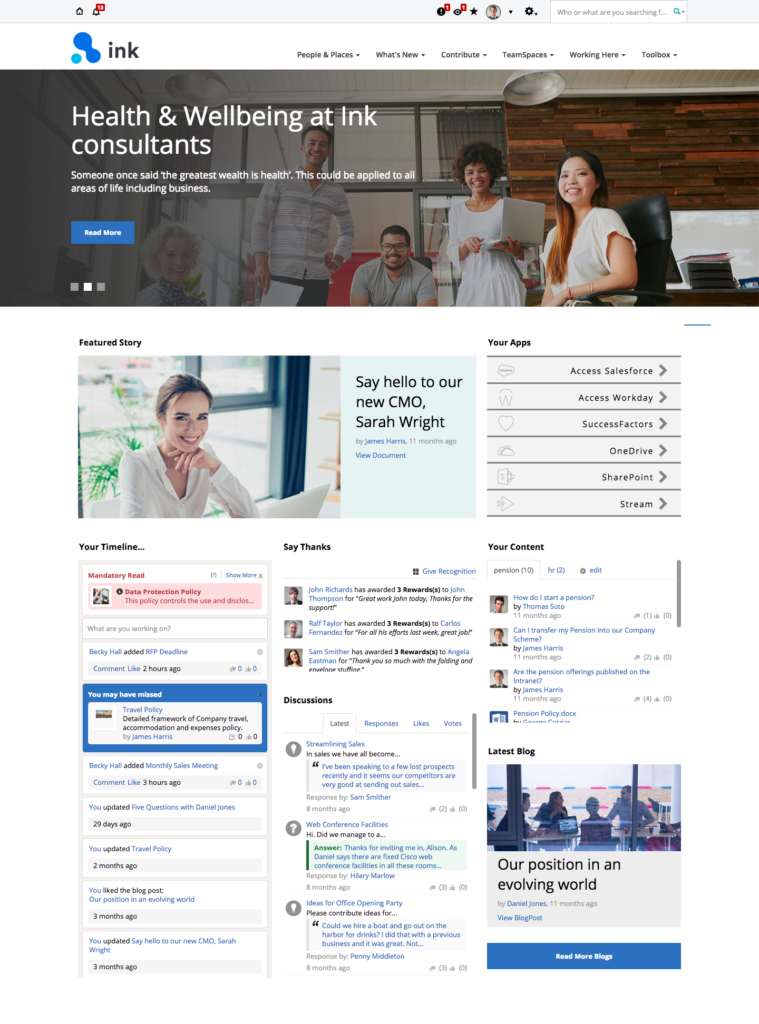
(Providing ‘quicklinks’ from your homepage to essential employee applications, such as your HR or Payroll systems, cloud storage, or Customer Service and CRM systems, can help streamline and improve your technology stack.)
3. Define roles and responsibilities
An essential part of implementing and managing a successful intranet is identifying roles and responsibilities: who can (and should) see or do what on your intranet. An intranet governance model sets out clearly the expectations of everyone involved and helps keep your intranet functioning smoothly after your intranet launch campaign. It will answer questions such as;
- Who is responsible for the intranet as a whole?
- Who are the stakeholders and what input or visibility do they require?
- How do we ensure our intranet stays on course to meet its objectives?
- Who will be adding and maintaining the content in each section of the intranet site?
- How do we ensure that the intranet is easy to manage and not confusing for users?
We typically recommend the RACI Model for intranet governance. The acronym RACI stands for:
- Responsible
The person who does the work to achieve the task. They have responsibility for getting the work done or decision made. As a rule, this is one person; examples might be a business analyst, application developer, or technical architect.
- Accountable
The person who is accountable for the correct and thorough completion of the task. This must be one person and is often the project executive or project sponsor. This is the role that Responsible is accountable to and the one who approves their work.
- Consulted
The people who provide information for the project and with whom there is two-way communication. This is usually several people, often subject matter experts.
- Informed
The people kept informed of progress and with whom there is one-way communication. These are people that are affected by the outcome of the tasks, so need to be kept up-to-date.
To implement the RACI model for your own intranet, you need to identify all the tasks involved in managing and/or evolving your intranet; then, identify all the project roles. For each task and each role, you then assign R, A, C, or I. Your RACI matrix will evolve as your intranet does; you may identify new tasks and responsibilities, while others may become redundant. An example matrix looks something like this:
| Activity | ELT | Stakeholder(s) | Intranet Manager(s) | Content Leads | Content Authors | IT | Steering Group |
|---|---|---|---|---|---|---|---|
| Strategic Planning | Consulted | Responsible | Accountable | Consulted | Informed | Informed | Consulted |
4. Content strategy and content audit
Your intranet should be structured and designed in a way that makes it easy for users to find what they’re looking for. To achieve this, consider how you will decide what content and information should be on your intranet. An audit of your existing content will help you identify:
- What content you have
- The quality, relevance, and age of your content
- Who owns or has responsibility for content, and where it resides
- Content that is redundant or no longer serves a purpose, or perhaps is out of date
- Any potential gaps that need to be addressed – missing or desired content
For example:
| Name | Versions | Stored | Owner | Updated | Comments | Recommendation |
|---|---|---|---|---|---|---|
| HR Policy | 2003, 2005, 2007, 2012 |
Shared drive Individual PCs HR Shared folder |
HR Manager | 2012 | Spelling and grammatical errors. Outdated content – doesn’t include latest pension information | Revised updated policy to be created by HR. Remove all previous versions from shared drives. |
Skipping over this step or simply ‘mass migrating’ all your existing content to your intranet can quickly cause chaos, as your intranet simply becomes a ‘dumping ground’ for information. It’s one of the greatest risks facing any intranet project and can rapidly lead to a drop in usage.
Our blog on ‘What content do I need on my intranet?’ takes you through the typical content types that usually make it onto the intranet launch list.
Download the essential intranet guide today
5. Structure planning
Using information gathered during your content audit, your next step is to consider how to group, organize, and categorize information on your intranet: creating a logical information architecture and clear navigation.
- Information architecture refers to how your content is organized and labeled
- Navigation is the process of moving from one place to another
An intuitive, easy-to-use structure has a marked impact on the overall user experience and can help drive those much-needed outcomes such as adoption and engagement. Techniques such as card sorting or categorization with your end users can help you brainstorm where users expect to find content, any common themes or groups, and the terminology or language commonly used.
6. Build your intranet brand
Building a brand for your intranet is key to creating something your users will love – and ultimately use. However, a ‘brand’ goes beyond design alone. It encompasses the personality of your intranet, the values of your business, and the perception of experience that creates. As part of your intranet brand, you will need to look at:
- Your intranet name and logo
- Brand color palette
- Fonts and typography
- Page designs and style sheets
- Icons, calls-to-action, and buttons
- Language or tone of voice, particularly on the main homepage/central pages
Will your internal intranet brand align with, or reference, your external one? Will your users be involved in determining the name or look and feel of your intranet? How can you help instill a sense of belonging amongst your users?
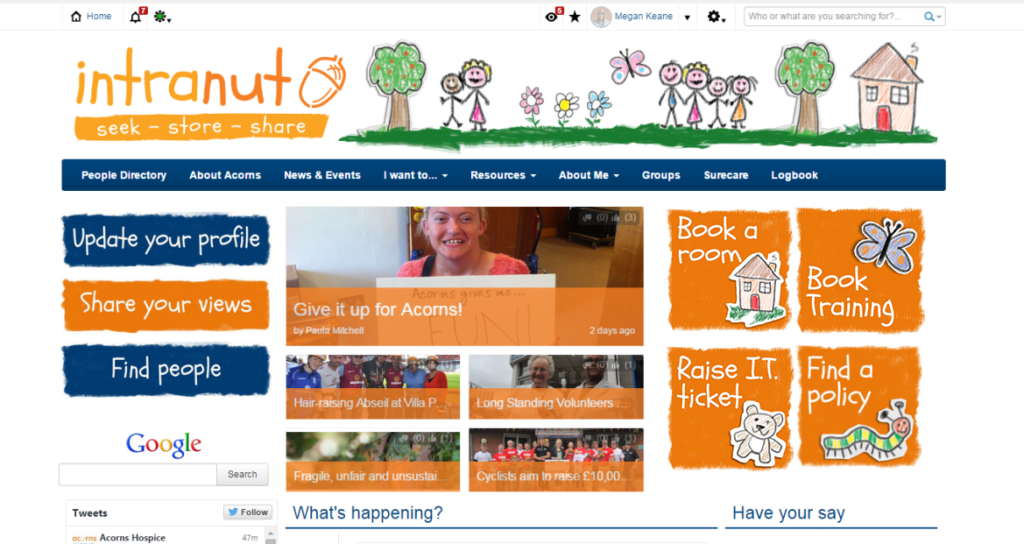
(Children’s charity Acorns aligned their intranet design with their external brand, using the same fonts and a spin-off on their company name for the intranet name. However, unique typography, fonts, and buttons established it as an internal brand and set it apart from the external one.)
We’ve seen some incredible designs from customers over the years. Why not check out the blog, ‘9 engaging intranet designs beyond the homepage’ for inspiration, or perhaps download our Design Annual?
7. Build structure and set permissions
With your sitemap determined and roles and responsibilities defined, you are ready to begin building your site. At this point, you will start creating the structure set out in step 5 and assigning permissions to users, ensuring they can see and do everything you need them to.
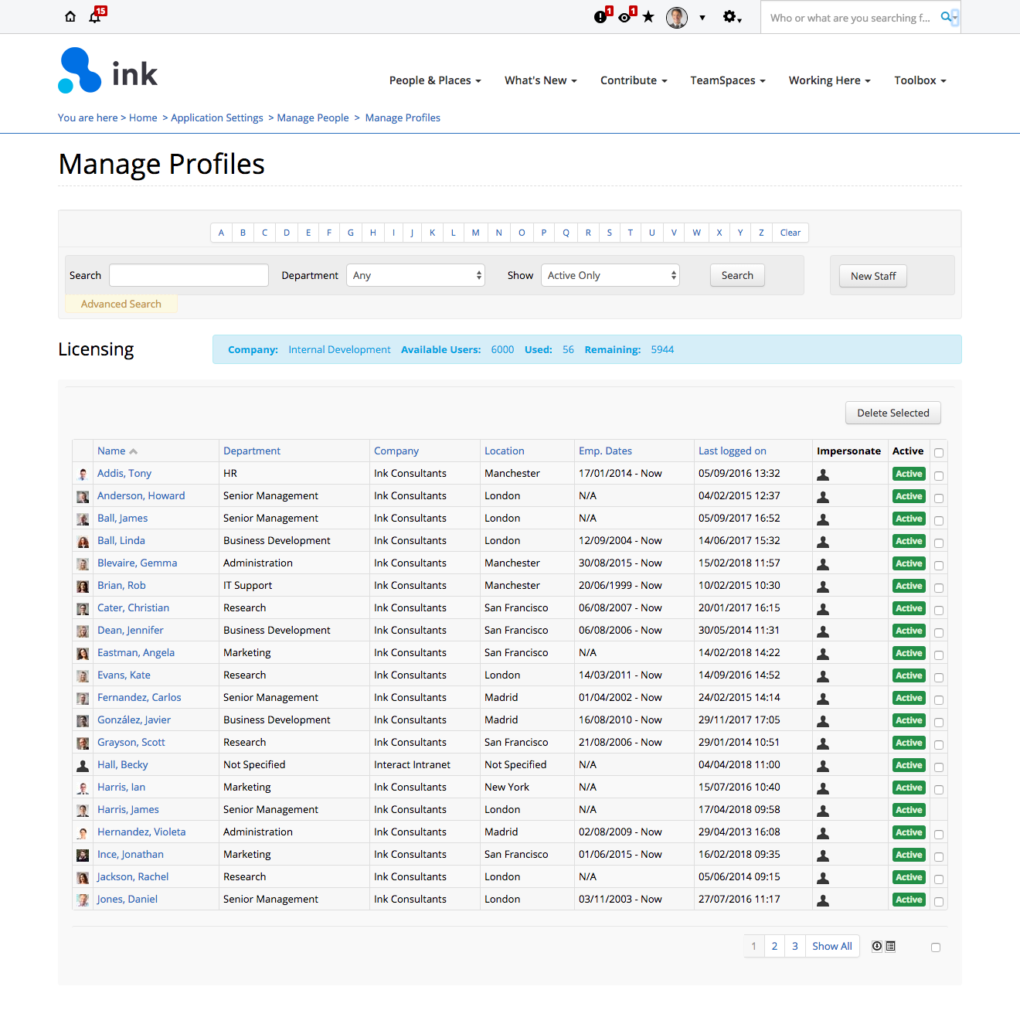
This is a key step to not only ensure your users aren’t privy to information they shouldn’t access, but are also enjoying a personalized experience of your intranet – for example, your users in New York aren’t seeing weather alerts for those based in the Florida office. It’s an internal communications approach proven to drive greater engagement.
8. Add content
With a structure in place, content areas created, and permissions assigned, you can begin adding your audited and updated content into your intranet.
This step is typically the longest part of your intranet project, depending on the number of pages you need to create. You may require additional resource, either internally or externally, to complete this stage.
9. Build homepages
Once your content has been uploaded, you can build and design your different homepages. With a platform like Interact, you can have multiple homepages to cater for defined user groups or personas; for example, new starters or senior management. Each team or content area will also have its own homepage. This helps push relevant information to the right people, making for a more efficient and engaging intranet experience.

(Tailor homepages to suit different user groups. Here, a New starter onboarding homepage shows an introductory video, introduces the new starter to their manager and an assigned buddy, and pushes a tasklist of things to complete as part of their orientation.)
10. Plan the launch
A well-planned launch is essential to get your users informed, excited, and engaged with your intranet. As part of your plan, you need to determine how to ensure your users:
- Are informed about what is happening, and when
- Understand the value of your intranet
- Know what the intranet is used for, and how it will impact and improve their day-to-day roles
- Adopt and continue to engage with the intranet from day one, and beyond
As part of the process, you will need to communicate to your users the fundamentals: such as how they can access the intranet, what their user name and password will be, and what is expected of them as a user. However, a successful launch goes beyond this. Depending on your intranet objectives and business culture, you may want to consider activities or a launch day to kick-off or celebrate your new intranet.
We’ve seen customers do everything from a naming competition for their intranet through to launch videos, intranet tours, treasure hunts, competitions, and branded goodies. A great story from Canterbury City Council shows a few of these ideas: check it out here.


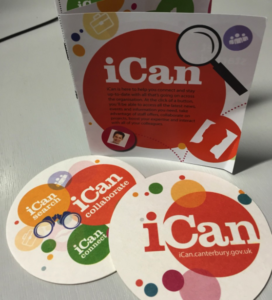
(Canterbury Council undertook a range of activities for the launch of their intranet, iCan. Branded goodies, informative leaflets, and demonstrations throughout launch day helped get users excited and engaged with their new intranet.)
Post-launch
Intranet success doesn’t stop at the launch. As a continually evolving and dynamic part of your business, your intranet requires constant investment and care to ensure it remains relevant and valuable.
Review performance of your intranet against the objectives you set. What actions are required to get it to where you need to go? If you’ve achieved your objectives, do you need to set new ones to ensure it continues to be a tool that supports your business? As part of your ongoing intranet management, you will need to:
- Measure and act upon feedback from users and stakeholders
- Use analytics and telemetry to identify areas for improvement, track user numbers and interactions, and identify gaps such as ‘Failure to Find’ searches or content requests
- Evaluate success and revisit your objectives regularly
- Conduct periodic strategic reviews of your intranet and its purpose, particularly as your business continues to grow and evolve
- Train and up-skill any new users, Content Authors, and Administrators to use and maintain your intranet effectively
Planning and deploying an intranet can feel like a mammoth task; the key is to approach it methodically as part of an ongoing journey. With a step-by-step approach, you can ensure no important elements are missed and ultimately, create a business-critical tool that engages every user from your front-line staff up to senior management.

